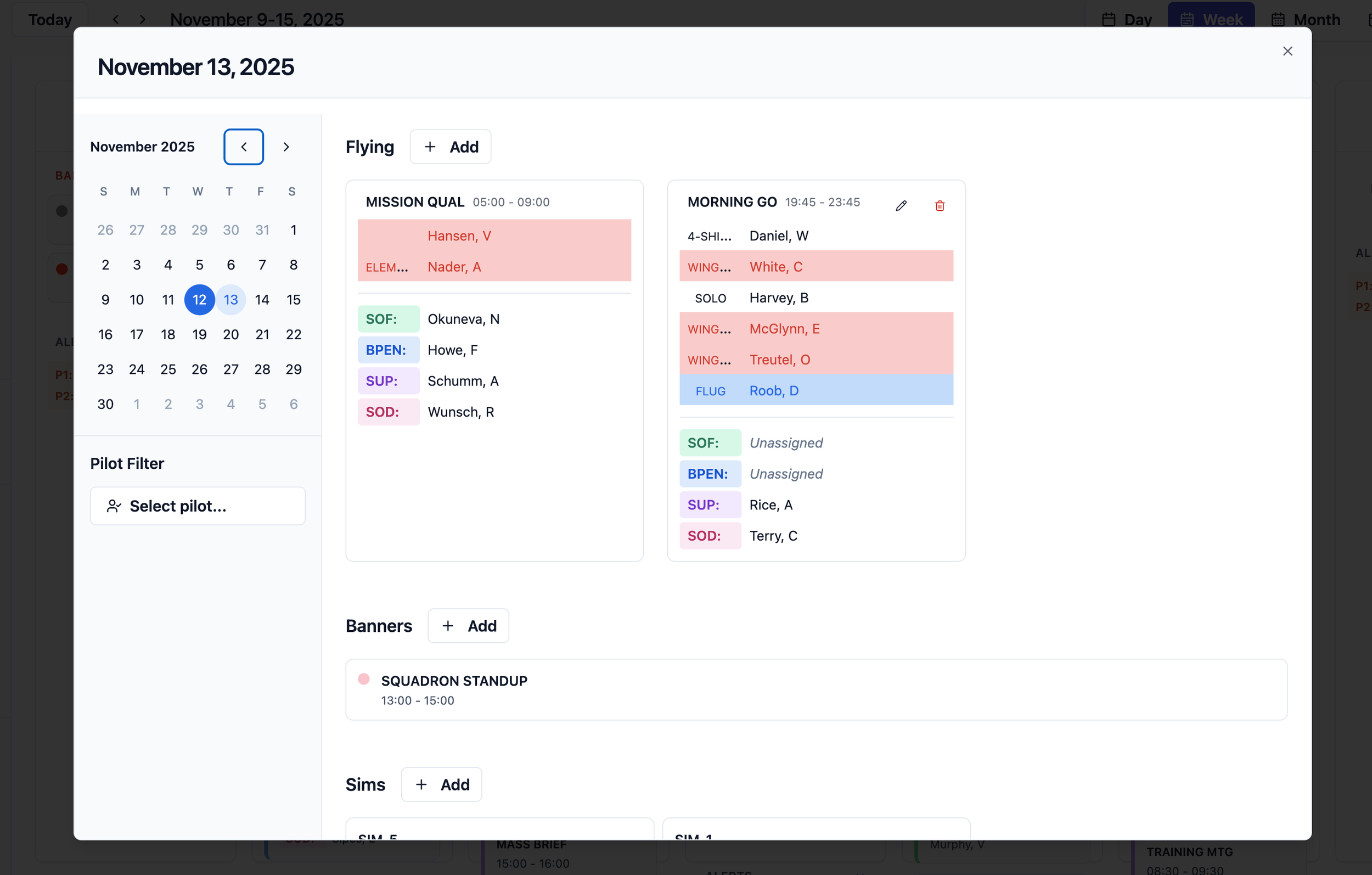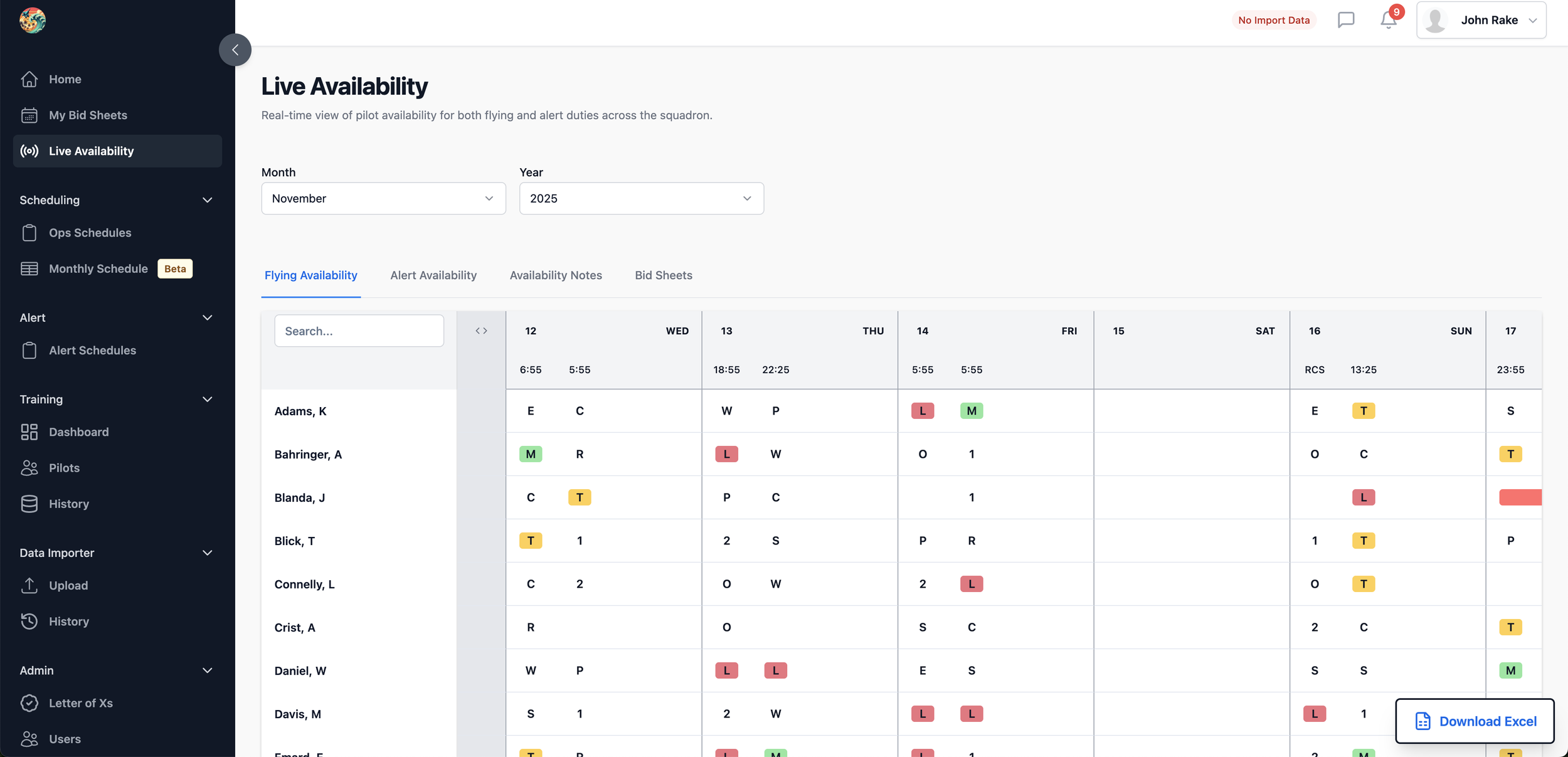Nalu Ops
Flight training and scheduling platform built for F-22 squadrons to replace manual Excel workflows and streamline daily operations.
The Problem
Military squadron scheduling is far more complex than typical business operations. An F-22 squadron's scheduling department was drowning in a sea of Excel spreadsheets—multiple versions of the same workflows shared across chat channels, manual conflict detection, and no centralized view of pilot availability. When scheduling conflicts arose (which happened frequently), resolving them required coordinating across multiple spreadsheets and communication channels, creating delays that directly impacted training timelines and combat readiness. With 24/7 operational requirements and pilots needing constant qualification maintenance, these inefficiencies weren't just inconvenient—they posed real risks to mission readiness.
The Solution
Nalu Ops is a comprehensive scheduling and operations management platform built specifically for military aviation units. The system consolidates all scheduling workflows into a single, real-time web application accessible to both schedulers and pilots.
The core is a custom-built monthly calendar interface that rivals Google Calendar or Outlook in usability, but with specialized enhancements for military scheduling needs. The platform handles everything from training bid submissions and flight assignments to alert schedules and ground duty rotations.
To handle the massive data ingestion requirements, we architected asynchronous processing using Google Cloud Workers, allowing the system to import training data from external military systems (ARMS and Artemis) without blocking user interactions. The platform provides instant visibility into pilot availability, automatic conflict detection, and streamlined workflows for making rapid scheduling adjustments—all critical capabilities when maintaining combat readiness.
Full-Stack Development
Product Thinking
Fast Iteration
Real-World Impact
Value First
Full-Stack Development Product Thinking Fast Iteration Real-World Impact Value First
Behind the Build
A quick look at how this project came together — the tools, design choices, and a few lessons learned along the way. In this short walkthrough, I share how I approached building it, what decisions shaped the final product, and how we balanced performance, usability, and real-world needs.
Key Capabilities
Real-time schedule visibility with automatic conflict detection
Live pilot availability tracking for instant decision-making
Custom calendar interface with drag-and-drop scheduling
Automated data integration with ARMS and Artemis systems
Comprehensive training history and qualification tracking
Streamlined bid sheet management for pilot preferences
24/7 alert schedule coordination and management
The Tech
Frontend: React, TypeScript, Vite, Tailwind CSS, Radix UI
Backend: NestJS, TypeScript, PostgreSQL, Prisma ORM
Infrastructure: Turborepo (Monorepo), Docker, Google Cloud Platform (Workers)
Additional: FullCalendar, React Query, Zustand
Reflection
The biggest learning curve was understanding the domain itself. Fighter pilot training requirements are incredibly complex, with rules and regulations that people spend entire careers mastering. We had to rapidly absorb this knowledge while building the system, which required close collaboration with squadron schedulers and a willingness to iterate based on their feedback. This experience reinforced the importance of domain expertise in building effective software—no amount of technical skill can replace understanding the problem space.
Looking forward, there are opportunities to enhance the platform with more predictive capabilities—using historical data to suggest optimal scheduling patterns or flag potential qualification gaps before they become critical. The metrics tracking system is also a key area for expansion, providing better visibility into training progress and resource utilization. The foundation we've built supports these enhancements, and the modular architecture makes it straightforward to add new capabilities as requirements evolve.
Want To Learn More?
Whether you’re hiring, brainstorming, or just want to talk shop, I’d love to hear from you. Send a quick message and I’ll follow up soon.







